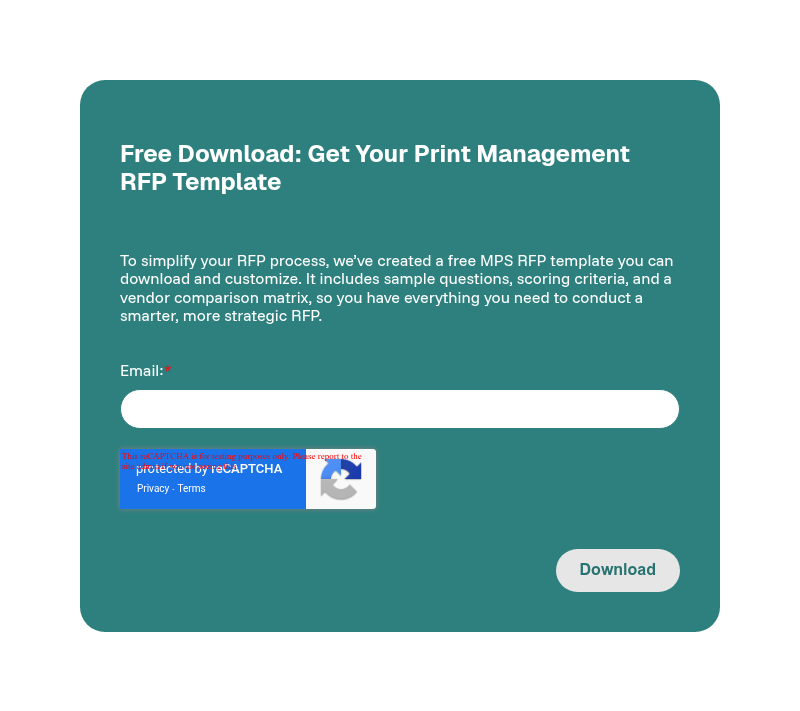Request for Proposals (RFPs) are a familiar part of procurement, especially in industries like manufacturing, healthcare, finance, and education, where transparency and due diligence matter. An RFP for Managed Print Services (MPS) is designed to help organizations compare print vendors side by side, ensuring the best mix of cost, service, and reliability.
But here’s the truth: while RFPs serve a purpose, they can also be time-consuming, overly rigid, and miss what really matters - finding the right partner, not just the lowest bid. Still, if your organization requires an RFP, asking the right print vendor questions can make all the difference.
This guide walks you through what to include in your Managed Print Services RFP to get meaningful, comparable responses and ensure the best long-term outcome for your business.
What is a Managed Print Service RFP?
A Managed Print Services RFP is a structured document used to gather detailed proposals from print vendors. It helps standardize print vendor questions and evaluation, making it easier to compare capabilities, pricing, and service models.
Typically, an MPS RFP includes:
- Company background and objectives
- Scope of services required
- Technical requirements
- Service level expectations
- Pricing and contract terms
Building it is usually a team effort involving IT leaders (for technology and security requirements), operations managers (for workflow and efficiency goals), and procurement teams (for cost and compliance).
Key benefits of a well-written MPS RFP
A well-structured RFP delivers clarity for both you and your potential vendors. The key benefits include:
- Improved cost visibility and vendor transparency: You can see not only the “per-page” cost but also the total cost of ownership, including service, supplies, and support.
- Easier comparison of service levels and pricing models: Standardized responses provide easier vendor comparisons.
- Reduced downtime and waste: When vendors provide data-driven insights, you’ll better understand print volumes, device utilization, and workflow bottlenecks.
Done right, an RFP can be a decision-making helper, not a paperwork burden.
Essential print vendor questions to include in your Managed Print Services RFP
When drafting your RFP, focus on questions that reveal how vendors deliver value, not just their price points.
Company background & experience
- How long have you provided managed print services?
- What industries or client sizes do you specialize in?
- Can you provide references or case studies?
These questions highlight experience and industry relevance. Look for a vendor with local presence and a reputation for exceptional service.
Technology & infrastructure
- What print management software do you use?
- How do you handle device monitoring, automation, and reporting?
- What cybersecurity measures are in place for print data?
Given rising security and compliance pressures, especially in healthcare and finance, you’ll want confidence in a vendor’s technology stack and data protection policies.
Service delivery & support
- What are your response and resolution times?
- How do you handle proactive maintenance and remote troubleshooting?
- What is your escalation process for service issues?
Reliable uptime matters more than most metrics. The best MPS partners deliver proactive services that prevent issues before they affect your teams.
Sustainability practices
- How do you help clients reduce paper and energy waste?
- Do you offer recycling programs or eco-friendly hardware options?
Sustainability is smart business. Energy-efficient devices and digital workflows can reduce costs and environmental impact.
Pricing & contract structure
- What is included in your cost-per-page model?
- How do you handle overages or fluctuations in print volume?
- What are your contract renewal and exit terms?
- Are consumables included in the pricing structure?
Transparency in pricing protects you from unexpected costs and ensures the flexibility to scale or pivot as your organization evolves.
How to evaluate vendor responses
Once proposals arrive, create a scoring matrix to compare vendors objectively. Consider including the following criteria:
- Product and service capability (25%) – hardware and software offerings, device monitoring, support model, and proactive maintenance
- Pricing and transparency (25%) – all-in pricing, total cost of ownership, contract terms, and value-added services
- Security and compliance (20%) – protecting sensitive data, following data privacy laws, and audit trails of print activity
- References and experience (20%) – client references, testimonials, and case studies that show the vendor’s expertise in similar environments
- Sustainability (10%) – energy-efficient device options, recycling programs, and processes to reduce paper waste
Be alert to red flags such as vague service level commitments, unclear billing terms, or add-on fees.
Tips for streamlining the MPS RFP process
If you must use an RFP, keep it efficient:
- Leverage print analytics to define your current usage baseline. Accurate data helps vendors tailor solutions.
- Involve stakeholders early from IT, finance, and operations to align goals and expectations.
- Use automation tools or AI to analyze RFP responses quickly and spot trends in vendor data.
These steps can shorten timelines and reduce the burden on your internal teams.
Common RFP mistakes to avoid
Many organizations fall into these RFP traps:
- Emphasizing price over value. The lowest bid may look attractive, but it often leads to hidden costs or inconsistent service.
- Failing to define performance metrics. Without clear KPIs and reporting expectations, accountability suffers.
- Neglecting data security. Print environments handle sensitive information, so ensure vendors are able to address compliance and cybersecurity.
- Choosing a support model that isn’t local or responsive. Opting for a support model that doesn’t offer easily accessible local assistance may lead to extended downtimes and slower resolution of on-site issues.
Choose a partner, not just a provider
An RFP can help you structure your search, but the real success comes from finding a partner who understands your business goals, provides reliable support, and grows with you.
If you’re preparing an RFP, use this guide to go beyond cost and uncover which vendors deliver real value, transparency, and long-term partnership. Ready to start your RFP?







